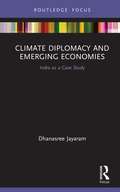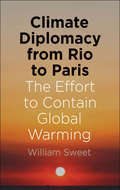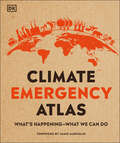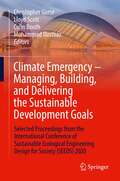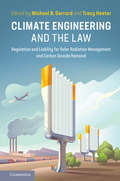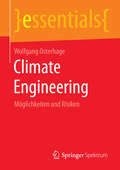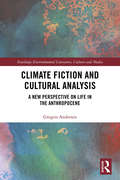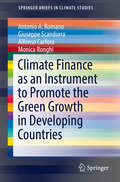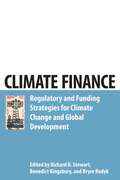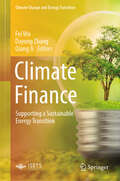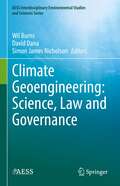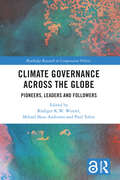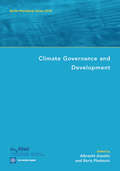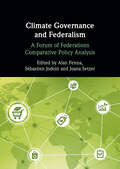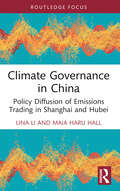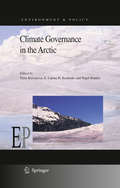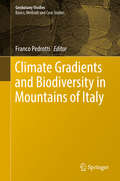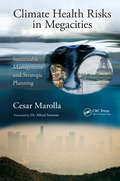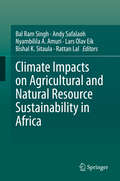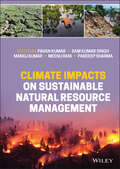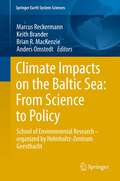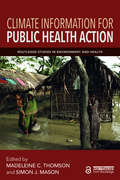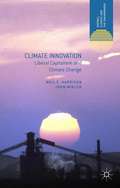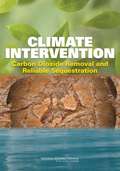- Table View
- List View
Climate Diplomacy and Emerging Economies: India as a Case Study (Routledge Focus on Environment and Sustainability)
by Dhanasree JayaramThis book analyses the role of the BASIC countries – Brazil, South Africa, India and China – in the international climate order. Climate Diplomacy and Emerging Economies explores the collective and individual positions of these countries towards climate diplomacy, focusing in particular on the time period between the 2009 and 2019 climate summits in Copenhagen and Madrid. Dhanasree Jayaram examines the key drivers behind their climate-related policies (both domestic and international) and explores the contributory role of ideational and material factors (and the interaction between them) in shaping the climate diplomacy agenda at multilateral, bilateral and other levels. Digging deeper into the case study of India, Jayaram studies the shifts in its climate diplomacy by looking into the ways in which climate change is framed and analyses the variations in perceptions of the causes of climate change, the solutions to it, the motivations for setting climate action goals, and the methods to achieve the goals. This book will be of great interest to students and scholars of climate change, environmental policy and politics and IR more broadly.
Climate Diplomacy from Rio to Paris: The Effort to Contain Global Warming
by William SweetThe essential primer for understanding climate diplomacy, describing both the major players and the path to progress, from the 1992 Rio Summit to the 2015 Paris Climate Conference Climate Diplomacy from Rio to Paris is the first accessible overview of climate diplomacy in its first quarter century. The author, who has reported on energy and climate for two decades, provides readers with a nuanced account of the major players and their interests--from the United States, the European Union, and China to environmental organizations, the United Nations, and the Vatican--and analyzes the outcomes of the major climate conferences at Rio, Kyoto, Copenhagen, and Paris.
Climate Emergency Atlas (DK Where on Earth? Atlases)
by Dan HookeOur house is on fire - it's time to wake up to the climate crisis facing planet Earth before it's too late.This unique graphic atlas tells you everything you need to know about climate change and what we can do to turn things around. Which countries generate the highest CO2 emissions? Which coastal cities are most vulnerable to rising sea levels? What will the polar ice caps look like in 10 years' time? Which countries have successfully harnessed renewable energy sources?Includes facts and figures and more than 30 dynamic maps, Climate Emergency Atlas is clear and easy to understand, making it the perfect reference guide for all young climate activists.
Climate Emergency – Managing, Building , and Delivering the Sustainable Development Goals: Selected Proceedings from the International Conference of Sustainable Ecological Engineering Design for Society (SEEDS) 2020
by Mohammad Dastbaz Christopher Gorse Colin Booth Lloyd ScottThrough research and proven practice, the aim of the International Conference of Sustainable Ecological Engineering Design for Society (SEEDS) is to foster ideas on how to reduce negative impacts on the environment while providing for the health and well-being of society. The professions and fields of research required to ensure buildings meet user demands and provide healthy enclosures are many and diverse. The SEEDS conference addresses the interdependence of people, the built and natural environments, and recognizes the interdisciplinary and international themes necessary to assemble the knowledge required for positive change.
Climate Engineering and the Law: Regulation And Liability For Solar Radiation Management And Carbon Dioxide Removal
by Michael B. Gerrard Tracy HesterClimate change is increasingly recognized as a global threat, and is already contributing to record-breaking hurricanes and heat waves. To prevent the worst impacts, attention is now turning to climate engineering - the intentional large-scale modification of the environment to reduce the impact of climate change. The two principal methods involve removing some carbon dioxide from the atmosphere (which could consume huge amounts of land and money, and take a long period of time), and reducing the amount of solar radiation reaching the earth's surface, perhaps by spraying aerosols into the upper atmosphere from airplanes (which could be done quickly but is risky and highly controversial). <P><P>This is the first book to focus on the legal aspects of these technologies: what government approvals would be needed; how liability would be assessed and compensation provided if something goes wrong; and how a governance system could be structured and agreed internationally.<P> In view of the disastrous Hurricanes Harvey, Irene and Maria, and the Trump administration's abandonment of action on climate change, increasing attention is going to climate engineering as a way to avoid the worst impacts of climate change.<P> Gives an overview of the relevant laws with detailed legal analysis Makes recommendations for what a governance system for climate engineering should entail.<P> Written and edited by established environmental law experts.
Climate Engineering: Möglichkeiten und Risiken (essentials)
by Wolfgang OsterhageUnter der Prämisse, dass ein Klimawandel stattfindet, arbeitet Wolfgang Osterhage eine Problemstellung heraus, die zu Lösungsvorschlägen im Rahmen des Climate Engineering führt, mit welchen das Klima pro-aktiv beeinflusst werden kann. Der Autor stellt die hierfür erforderlichen technischen Maßnahmen vor. In die Bewertung von Risiken fließen thermodynamische und chaostheoretische Überlegungen ein, die zu einer kritischen Beurteilung führen. Weitere Bewertungskriterien ergeben sich schließlich aus ethischen Grundsatzüberlegungen.
Climate Fiction and Cultural Analysis: A new perspective on life in the anthropocene (Routledge Environmental Literature, Culture and Media)
by Gregers AndersenClimate Fiction and Cultural Analysis argues that the popularity of the term "climate fiction" has paradoxically exhausted the term’s descriptive power and that it has developed into a black box containing all kinds of fictions which depict climatic events and has consequently lost its true significance. Aware of the prospect of ecological collapse as well as our apparent inability to avert it, we face geophysical changes of drastic proportions that severely challenge our ability to imagine the consequences. This book argues that this crisis of imagination can be partly relieved by climate fiction, which may help us comprehend the potential impact of the crisis we are facing. Strictly assigning "climate fiction" to fictions that incorporate the climatological paradigm of anthropogenic global warming into their plots, this book sets out to salvage the term’s speculative quality. It argues that climate fiction should be regarded as no less than a vital supplement to climate science, because climate fiction makes visible and conceivable future modes of existence within worlds not only deemed likely by science, but which are scientifically anticipated. Focusing primarily on English and German language fictions, Climate Fiction and Cultural Analysis shows how Western climate fiction sketches various affective and cognitive relations to the world in its utilization of a small number of recurring imaginaries, or imagination forms. This book will be of great interest to students and scholars of ecocriticism, the environmental humanities, and literary and culture studies more generally.
Climate Finance as an Instrument to Promote the Green Growth in Developing Countries (SpringerBriefs in Climate Studies)
by Antonio A. Romano Giuseppe Scandurra Alfonso Carfora Monica RonghiThis book analyses the effectiveness of climate finance as political instrument to reduce the effect of anthropogenic activities on climate change and promote the green growth in developing countries. The book highlights that close attention should also be paid to the analysis of political contexts in a broad sense. Particularly focusing on the international negotiations process that enables the direction of funds toward specific needs and priorities and the issue of access to electricity. For example, the difficulties that developing countries face when trying to improve their green economic development without access to carbon remains a matter of the utmost importance and urgency for many developing countries that lack significant aid from developed countries. This book will be of interest to a wide body of academics and practitioners in climate change and energy policies. Moreover, this project is a valid instrument for students in energy policies and climate programs.
Climate Finance: Regulatory and Funding Strategies for Climate Change and Global Development
by Richard B. Stewart Benedict Kingsbury Bryce RudykPreventing risks of severe damage from climate change not only requires deep cuts in developed country greenhouse gas emissions, but enormous amounts of public and private investment to limit emissions while promoting green growth in developing countries. While attention has focused on emissions limitations commitments and architectures, the crucial issue of what must be done to mobilize and govern the necessary financial resources has received too little consideration. In Climate Finance, a leading group of policy experts and scholars shows how effective mitigation of climate change will depend on a complex mix of public funds, private investment through carbon markets, and structured incentives that leave room for developing country innovations. This requires sophisticated national and global regulation of cap-and-trade and offset markets, forest and energy policy, international development funding, international trade law, and coordinated tax policy.Thirty-six targeted policy essays present a succinct overview of the emerging field of climate finance, defining the issues, setting the stakes, and making new and comprehensive proposals for financial, regulatory, and governance mechanisms that will enrich political and policy debate for many years to come. The complex challenges of climate finance will continue to demand fresh insights and creative approaches. The ideas in this volume mark out starting points for essential institutional and policy innovations.
Climate Finance: Supporting a Sustainable Energy Transition (Climate Change and Energy Transition)
by Fei Wu Qiang Ji Dayong ZhangThis book focuses on the frontier issues in climate finance and aims to develop a general framework to understand the financial pathways towards a successful energy transition. It builds upon the general descriptions of the current status and future challenges towards carbon neutral targets, and then bring forward a combination of theoretical and empirical analysis on the critical issues related to climate finance. Estimated by the International Energy Agency (IEA), trillions dollars of investment in energy sector are needed to achieve net-zero emission scenario. It provides a huge opportunity for our economies, meanwhile creates considerable challenges to the existing system. Both financing and investment in such an unprecedented scale cannot possibly be satisfied by the current financial architecture, which creates demands for restructuring in the financial sector, developing innovative financial instruments, building mechanisms to attract private investment, and establishing human resources to facilitate climate financing and investment. This area is essentially interdisciplinary, which requires a fundamental reconsideration of standard approaches. Aiming to satisfy the broad interests from both academia and policymakers, the contents of this book range from general discussions on critical issues to advanced statistical analyses on key topics. Authors hope to bring forward a general picture about climate finance and facilitate the demands for both academic research and policymaking. It should also provide a good guidance for graduate students interested in this subject. The main contents of this book are based on solid research outcomes but with clear policy relevance. The book combines finance theory and practices in both financial markets and energy sectors to reflect the complex nature of financing for energy transition. While the materials can provide useful knowledge to policymakers, the book can also inspire new research ideas in the relevant area.
Climate Geoengineering: Science, Law and Governance (AESS Interdisciplinary Environmental Studies and Sciences Series)
by Wil Burns David Dana Simon James NicholsonThe sobering reality of the disconnect between the resolve of the world community to effectively address climate change, and what actually needs to be done, has led to increasing impetus for consideration of a suite of approaches collectively known as “climate geoengineering,” or “climate engineering.” Indeed, the feckless response of the world community to climate change has transformed climate geoengineering from a fringe concept to a potentially mainstream policy option within the past decade. This volume will explore scientific, political and legal issues associated with the emerging field of climate geoengineering. The volume encompasses perspectives on both of the major categories of climate geoengineering approaches, carbon dioxide removal and solar radiation management.
Climate Governance across the Globe: Pioneers, Leaders and Followers (Routledge Research in Comparative Politics)
by Rüdiger K.W. Wurzel, Mikael Skou Andersen and Paul TobinThis book takes an innovative approach to studying international climate governance by providing a critical analysis of climate leadership, pioneership and followership across the globe. The volume assesses the interactions between climate leaders, pioneers and followers, across multilevel and/or polycentric climate governance contexts. Examining the state and sub-state levels in both the Global South and Global North, as well as regional, supranational EU and international climate governance levels, the authors explore 16 countries across Asia, Australasia, Europe, and Central and North America, plus the European Union. Each chapter employs a comprehensive and consistent framework for analyzing leadership and pioneership, as well as followership. The findings provide new insights into the strategies and actions of sub-state, state-level, and supranational leaders and pioneers. This book will be of key interest to scholars, students and practitioners in environmental politics and climate change governance, as well as those interested in political elites, EU studies and, more broadly, comparative politics and international relations.
Climate Governance across the Globe: Pioneers, Leaders and Followers (Routledge Research in Comparative Politics)
by Rüdiger K.W. Wurzel, Mikael Skou Andersen and Paul TobinThis book takes an innovative approach to studying international climate governance by providing a critical analysis of climate leadership, pioneership and followership across the globe.The volume assesses the interactions between climate leaders, pioneers and followers, across multilevel and/or polycentric climate governance contexts. Examining the state and sub-state levels in both the Global South and Global North, as well as regional, supranational EU and international climate governance levels, the authors explore 16 countries across Asia, Australasia, Europe, and Central and North America, plus the European Union. Each chapter employs a comprehensive and consistent framework for analyzing leadership and pioneership, as well as followership. The findings provide new insights into the strategies and actions of sub-state, state-level, and supranational leaders and pioneers.This book will be of key interest to scholars, students and practitioners in environmental politics and climate change governance, as well as those interested in political elites, EU studies and, more broadly, comparative politics and international relations.The Open Access version of this book, available at www.taylorfrancis.com, has been made available under a Creative Commons Attribution-Non Commercial-No Derivatives (CC-BY-NC-ND) 4.0 license.
Climate Governance and Development: Berlin Workshop Series 2010
by Boris Pleskovic Albrecht AnsohnThe Berlin Workshop Series 2010 presents selected papers from meetings held September 28-30, 2008, at the eleventh annual forum co-hosted by InWEnt and the World Bank in preparation for the Bank's annual World Development Report. At the 2008 meetings, key researchers and policy makers from Europe, the United States, and developing countries met to explore the problems that climate governance poses for development, which are later examined in depth in the 'World Development Report 2010'. This volume presents papers from the Berlin workshop sessions on climate governance and development, covering climate change as a development priority; policies and technologies for energy and development; natural resource governance for adaptation, mitigation, and development; non-state actors and climate governance; financing adaptation and mitigation in an unequal world; and changing institutions of governance for climate change. IN THIS VOLUME: Introduction by Aehyung Kim and Boris Pleskovic; opening remarks by Carola Donner-Reichle; keynote addresses by Rosina Bierbaum and Justin Yifu Lin; and papers by Richard J. T. Klein, Judith A. Layzer, Claudia Kemfert, Siri Eriksen, Kedziora and Zbigniew W. Kundzewicz, David Rogers, Charlotte Streck, John Scanlon and Clara Nobbe, and Hugh Compston and Ian Bailey.
Climate Governance and Federalism: A Forum of Federations Comparative Policy Analysis
by Sébastien Jodoin Alan Fenna Joana SetzerThe majority of the world's largest carbon emitters are either federations or have adopted systems of decentralised governance. The realisation of the world's climate mitigation objectives therefore depends in large part on whether and how governments within federal systems can cooperate to reduce carbon emissions and catalyse the emergence of low-carbon societies. This volume brings together leading experts to explore whether federal or decentralised systems help or hinder efforts to mitigate and adapt to climate change. It reviews the opportunities and challenges federalism offers for the development and implementation of climate mitigation and adaption policies and identifies the conditions that influence the outcomes of climate governance. Including in-depth case studies of 14 different jurisdictions, this is an essential resource for academics, policymakers and practitioners interested in climate governance, and the best practices for enhancing climate action. This title is also available as Open Access on Cambridge Core.
Climate Governance in China: Policy Diffusion of Emissions Trading in Shanghai and Hubei (Routledge Focus on Environment and Sustainability)
by Lina Li Maia Haru HallThis book explores how and why innovative climate policies spread across subnational regions and between governance levels in China. Despite the significance of emerging economies in a pathway to a zero-carbon future, research to date on China’s transformation governance remains limited. Drawing on a theoretical framework for policy diffusion and based on extensive data from expert interviews with Chinese decisionmakers and policy practitioners, Lina Li and Maia Haru Hall focus on the policy of emissions trading systems (ETS) and two key case studies: Shanghai and Hubei. The authors examine the role of the national government and how much freedom the subnational regions have in developing ETS policy, as well as pinpointing key actors and the role of policy and knowledge diffusion mechanisms. Overall, this book sheds light on the competition between China and the West in the transition to climate-friendly societies and economies, highlighting opportunities for cooperation between them. This book will be of great interest to students and scholars of environmental politics and policy, climate change, urban studies, and Chinese studies more broadly.
Climate Governance in the Arctic (Environment & Policy #50)
by E. Carina Keskitalo Nigel Bankes Timo KoivurovaClimate change is affecting the Arctic environment and ecosystems at an accelerating speed, twice the rate of the global average. This is opening the Arctic to transportation and resource development and creating serious challenges for local communities and indigenous peoples. Climate Governance in the Arctic considers two aspects of climate change from an institutional perspective. It focuses on how relevant regimes, institutions and governance systems support mitigation of climate change. It also examines the extent to which the varying governance arrangements in the Arctic support adaptation and the development of adaptation processes for the region. The book's focus on Arctic governance offers unique insights within climate change mitigation and adaptation research.
Climate Gradients and Biodiversity in Mountains of Italy (Geobotany Studies)
by Franco PedrottiThis volume gathers case studies on plant diversity from selected, representative mountain systems of Italy (Mediterranean and temperate zones), while also addressing the biodiversity of avian fauna. For the Alps, Wilhalm and Prosser examine the species biodiversity (also with the help of highly detailed location maps) of the sector of the central Alps that corresponds to the basin of the Adige, including some nearby valleys, between the watershed to the north and the Prealps to the south (Alto Adige and Trentino). In turn, Pedrotti investigates the vegetation series of the same territory in relation to the three climatic sectors identified: prealpine, alpine and endoalpine. Aleffi then explores the relationships between the distribution of a number of species of bryophytes and the main mesoclimatic gradients along a transect through the Valle dell' Adige between 46#65533;40'N and 45#65533;42'N. Lastly, Siniscalco studies the ways in which alien species are now invading the western Alps, which to date have remained largely unaffected by this phenomenon, unlike the plains and hills. For the Apennines, Ferrari studies the tree line and the biodiversity of the vegetation of the northern Apennines; for the mountains of Sicily, Bazan conducts a diachronic analysis of the beech forests of the Monti Nebrodi. The contribution by Venanzoni interprets the chorology of associations of the Magnocaricetalia order throughout Italy, relating it to the climatic and geographic gradients. He describes a total of 55 associations, reporting on the distribution in the temperate zone (differentiating between the alpine and continental) and the Mediterranean zone for each of them. Cianfaglione presents the Signal Project Italian site. This project investigates the effects of extreme weather events on secondary grassland and the role of selected alien species, mowing, biodiversity, productivity and functional traits, in Italy and along a European gradient. For the Marches Region, Forconi describes the biodiversity of the avian fauna in relation to the altitudinal gradient and the potential vegetation.
Climate Health Risks in Megacities: Sustainable Management and Strategic Planning
by Cesar MarollaClimate Health Risks in Megacities: Sustainable Management and Strategic Planning courageously confronts the immense challenges of alleviating climate change and takes the initiative to layout an agenda that calls for action in the rapidly changing landscape of our global climate. This guide provides a constructive methodology for developing and implementing risk management and operational continuity management systems to climate change effects on urban populations. It addresses key issues such as physical location, proper sanitation, food security and vector-borne diseases against the backdrop of climate change, and then model its effect on the urban dwellers. The author also reveals the benefits of implementing a unique risk management approach to combat global threats and focuses on building urban resilience in the face of disasters. Prepared with a comprehensive and forward-thinking style, this book draws on indispensable case studies in key megacities like New York, Los Angeles, Beijing, Rio de Janeiro, London, Mumbai, and Lagos, and links researchers, scientists, city’s mayors, environmentalists, policy-makers and world leaders from central areas to review, reflect, and expound on future directions.
Climate Impacts on Agricultural and Natural Resource Sustainability in Africa
by Rattan Lal Bal Ram Singh Lars Olav Eik Andy Safalaoh Nyambilila A. Amuri Bishal K. SitaulaThis book discusses knowledge-based sustainable agro-ecological and natural resource management systems and best practices for sustained agricultural productivity and ecosystem resilience for better livelihoods under a changing climate. With a focus on agriculture in Africa, the book assesses innovative technologies for use on smallholder farms, and addresses some of the key Sustainable Development Goals to guide innovative responses and enhanced adaptation methods for coping with climate change.Contributions are based on 'Capacity Building for Managing Climate Change in Malawi' (CABMACC), a five-year program with an overall goal to improve livelihoods and food security through innovative responses and enhanced capacity of adaptation to climate change. Readers will discover more about sustainable crop production, climate smart agriculture, on-farm energy supply from biogas and the potential of soil carbon sequestration in crop-livestock systems.
Climate Impacts on Sustainable Natural Resource Management
by Manoj Kumar Pavan Kumar Meenu Rani Pardeep Sharma Ram Kumar SinghCLIMATE IMPACTS ON SUSTAINABLE NATURAL RESOURCE MANAGEMENT Climate change has emerged as one of the predominant global concerns of the 21st century. Statistics show that the average surface temperature of the Earth has increased by about 1.18°C since the late 19th century and the sea levels are rising due to the melting of glaciers. Further rise in the global temperature will have dire consequences for the survival of humans on the planet Earth. There is a need to monitor climatic data and associated drivers of changes to develop sustainable planning. The anthropogenic activities that are linked to climate change need scientific evaluation and must be curtailed before it is too late. This book contributes significantly in the field of sustainable natural resource management linked to climate change. Up to date research findings from developing and developed countries like India, Indonesia, Japan, Malaysia, Sri Lanka and the USA have been presented through selected case studies covering different thematic areas. The book has been organised into six major themes of sustainable natural resource management, determinants of forest productivity, agriculture and climate change, water resource management and riverine health, climate change threat on natural resources, and linkages between natural resources and biotic-abiotic stressors to develop the concept and to present the findings in a way that is useful for a wide range of readers. While the range of applications and innovative techniques is constantly increasing, this book provides a summary of findings to provide the updated information. This book will be of interest to researchers and practitioners in the field of environmental sciences, remote sensing, geographical information system, meteorology, sociology and policy studies related to natural resource management and climate change.
Climate Impacts on the Baltic Sea: School of Environmental Research - Organized by the Helmholtz-Zentrum Geesthacht (Springer Earth System Sciences)
by Anders Omstedt Brian R. Mackenzie Keith Brander Marcus ReckermannThe Baltic Sea area is an old cultural landscape with a well developed international framework for monitoring, assessing and managing its marine ecosystems. It provides a good case study for other regions where such management is being set up. The chapters in this book are based on lectures given at a summer school on the Baltic Sea island of Bornholm in the summer of 2009. They cover a range of topics, spanning from detailed descriptions of political agreements that protect the marine environment, to basic modelling instructions, to an assessment of the possible impacts of climate change on the marine ecosystem, to a reflection on the role of climate scientists and their responsibility in society. This interdisciplinary book is primarily directed at students and lecturers of the environmental disciplines to provide an overview of the possible impacts of climate change on the Baltic Sea. It is also intended to serve as a background reference for scientists and policy makers, both for the Baltic Sea area and more generally. The book is a contribution to the BALTEX programme and to the BONUS+ projects ECOSUPPORT and Baltic-C.
Climate Information for Public Health Action (Routledge Studies in Environment and Health)
by Madeleine C. Thomson Simon J. MasonPolicy-makers are increasingly concerned about the impact of climate variability and change on the health of vulnerable populations. Variations and trends in climatic factors and extreme weather events impact many health outcomes, including malaria, heat stress and undernutrition. Climate Information for Public Health Action is based on the premise that climate knowledge and information can help protect the public from climate-sensitive health risks. With a focus on infectious disease, hydro-meteorological disasters and nutrition, the book explores why, when and how data on the historical, current and future (from days to decades) climate can be incorporated into health decision-making. Created as a collaborative effort between climate and health experts, this book targets a broad technical public health community, alongside development practitioners and policy-makers engaged in climate change adaptation. It may also guide climate experts in the development of climate services tailored to health needs. Written in an accessible, informative style, while maintaining the highest technical and scientific standards, it will also be a valuable resource for students and academics studying and working in the emerging field of environment and health. The Open Access version of this book, available at http://www.tandfebooks.com/doi/view/10.4324/9781315115603, has been made available under a Creative Commons Attribution-Non Commercial-No Derivatives 4.0 license."
Climate Innovation
by John Mikler Neil E. HarrisonA comprehensive examination of the inability of liberal capitalism to generate the technological innovations necessary to prevent dangerous climate change. The case is made for the need for institutional evolution to drive the climate innovation, and the potential for climate innovation in an increasingly economically interconnected world.
Climate Intervention: Carbon Dioxide Removal and Reliable Sequestration
by Committee on Geoengineering Climate: Technical Evaluation Discussion Of ImpactsThe signals are everywhere that our planet is experiencing significant climate change. It is clear that we need to reduce the emissions of carbon dioxide and other greenhouse gases from our atmosphere if we want to avoid greatly increased risk of damage from climate change. Aggressively pursuing a program of emissions abatement or mitigation will show results over a timescale of many decades. How do we actively remove carbon dioxide from the atmosphere to make a bigger difference more quickly? As one of a two-book report, this volume of "Climate Intervention" discusses CDR, the carbon dioxide removal of greenhouse gas emissions from the atmosphere and sequestration of it in perpetuity. "Climate Intervention: Carbon Dioxide Removal and Reliable Sequestration" introduces possible CDR approaches and then discusses them in depth. Land management practices, such as low-till agriculture, reforestation and afforestation, ocean iron fertilization, and land-and-ocean-based accelerated weathering, could amplify the rates of processes that are already occurring as part of the natural carbon cycle. Other CDR approaches, such as bioenergy with carbon capture and sequestration, direct air capture and sequestration, and traditional carbon capture and sequestration, seek to capture CO2 from the atmosphere and dispose of it by pumping it underground at high pressure. This book looks at the pros and cons of these options and estimates possible rates of removal and total amounts that might be removed via these methods. With whatever portfolio of technologies the transition is achieved, eliminating the carbon dioxide emissions from the global energy and transportation systems will pose an enormous technical, economic, and social challenge that will likely take decades of concerted effort to achieve. "Climate Intervention: Carbon Dioxide Removal and Reliable Sequestration" will help to better understand the potential cost and performance of CDR strategies to inform debate and decision making as we work to stabilize and reduce atmospheric concentrations of carbon dioxide.
